This is the second in a series of posts about the development of women’s six day races from 1981 onwards. In 1981, Marcy Schwam of the USA became the first woman to compete in a six day race since the revival of the format in 1980. Her “new era” record of 384 miles (617.988 km) stood for just over a year1. Nottingham in the UK was the next stop in the history of the women’s six day races. A 23-year-old British runner, Ros (Rosalind) Paul (born 1959), a PE teacher from Elstree, broke Schwam’s record. Ros Paul was the first British woman to compete in a six day race in the new era of track ultramarathons.
The Charles Rowell Six Day Race, Nottingham
The race was named after Charles Rowell, a successful professional pedestrian of the Victorian era from Cambridge2. Rowell competed in the 1870s and 1880s and raced against the American Edward Payson Weston. The race where Marcy Schwam set the record in 1981 was named after Payson Weston.
Seventeen men had taken part in the first Charles Rowell Six Day Race in November 1981. They included Don Choi from the USA, organiser of the first six day race in 1980, held in the USA. Mike Newton of South London Harriers had won, covering just over 505 miles, a “new era” record.
In 1982, 25 runners took part, including Don Choi and Mike Newton again. Ros Paul was the only woman in the race. Only one runner retired early.
The race started at noon on 22nd August 1982 finishing on 28th August.
According to Andy Milroy’s report on the six day race in the Road Runners Club Newsletter, ‘the organisers… had set up a small village of tents, marquees and caravans at the start of the race… Almost every need of the competitors was catered for – hot meals, laundry, physiotherapy, even an expert on sports injuries was on call‘3.
The Harvey Hadden stadium
The race took place at the Harvey Hadden stadium on the 400m tartan athletics track which had a banked 479m cycle velodrome around it4.
Two months’ earlier, the Harvey Hadden track had hosted an ultramarathon which was of historic significance for two reasons. Firstly, it was the first 48 hour track race to be held in the UK in the twentieth century. Secondly, it was the first time that a woman had competed alongside men in a long-distance track event in the UK. Ann Sayer, a walker, competed, finishing sixth overall and setting a new women’s world record of 294.114 kilometres (182 miles, 1326 yards)5.
Ros Paul’s account of the Charles Rowell Six Day Race – the first 48 hours
This account is taken from the Road Runners Club Newsletter, January 19836.
Numerous telephone calls preceded the race as I sought advice on how to tackle this monumental event. Surprisingly, the advice received from the ‘veterans’ varied greatly. Some advise taking it easy with plenty of relaxation and long rest periods.
Naturally, all my carefully laid plans failed to work. I had intended to run no more than 80 miles the first day, but I found I was going so well that after 10 hours, John Towers, with whom I was running, persuaded me to have a go at the 24 hour track record of 134 miles. He felt this would then give me a mental boost to tackle the other 5 days.
Weather conditions were good, and much to my surprise I completed the 135 miles by 12 noon on Monday.
After coming off for a bath, a meal and a sleep, I returned to the track about 5pm. Another target was set, the 48 hour track record of 182 miles. After what seemed an endless, slow crawl round the track the target was achieved by 12 noon on Tuesday. I completed a few more laps towards the 300km mark (186 miles) before coming off the usual bath, meal and rest.
The June 1983 issue of the Marathon and Distance Runner (for more on this magazine read Magazines of the Marathon Boom) featured an article by Maurice Dillon reviewing the top performances in six day races to date. This included a table for each of the six record breaking performances, four by men and two by women. Dillon pointed out that Ros Paul had covered the highest mileage of all six runners in the first 24 hours. This was perhaps not surprising as she was attempting to break the 24 hour record.
Ros Paul’s 24 hour distance was 216.648km, breaking the record another British ultrarunner, Lynn Fitzgerald, had set at the Gloucester 24 Hour Track Race in May (214.902km). Her 48 hour distance was 299.908km. This broke the record set by Ann Sayer, walking, at the Nottingham 48 Hour Track Race four months before (294.114km).
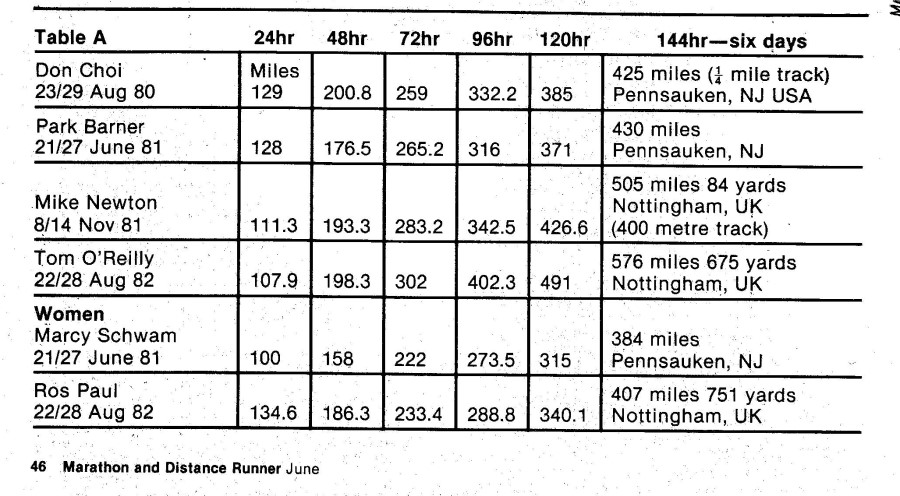
Ros Paul – breaking the women’s six day race record
Running between 2am and dawn was proving a bit of a psychological barrier, particularly when, like most others, I was suffering badly with sore shins. The running pattern was therefore altered so that I could snatch some rest during the ‘small hours’.
The 200 mile mark was reached after a few hours rest on Tuesday evening and from then onwards the event became a sort of dream. (Mainly a bad dream).
I seemed to be walking, limping and running, between treatment for the tendonitis which was not improving. If I stopped for more than 10 minutes I virtually seized up and had to walk at least 2 laps before I could attempt a jog. Over all it was a crying demand for rest and sleep. Without the verbal encouragement of other runners and the race officials, I doubt if could have continued.
The breakthrough came on Friday morning. A good rest and a meal, and things were looking brighter. There was light at the end of the tunnel. With 350 miles completed I began to take more interest. The target of 384 miles looked possible.
The tempo quickened. Everybody was going faster. Excitement was in the air. The 384 mile target came up and I felt great. Immediately a new target was produced by Andy Milroy. The old professional record of Victorian times, 393 miles. Only another 9 miles, but when this was reached yet another target was produced by Bromley Clarke. “You must complete 400 miles”, he said. “I’ve ordered a golden trophy for you”. Another 7 miles. At last this was achieved, and with a little time and surprisingly, a little adrenalin left, a few more miles were added and the dream came to an end.
Ros Paul – memories
Memories? The reception at the beginning. The jokes, the obvious attack of nerves, the calm appearance of the “Vets”. The help and encouragement received, in particular from John Towers, Jean Claud [Jean-Claude Czaja], Andy Milroy with his endless knowledge and statistics, and Brom Clarke, with his pep talks.
Last but not least, the other runners and handlers. What a fantastic group of people. Where in the world could you find such company.
Bromley Clarke was the race organiser and member of a local club, Berry Hill Athletic Club. He had competed in the Gloucester 24 Hour Track Race that May.
Ros Paul’s six day world record
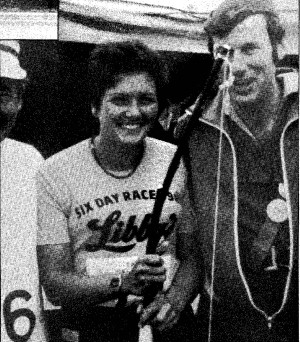
Photograph by Maurice Dillon
Ros Paul set a new women’s world six day record of 655.689km (407 miles 741 yards), improving on Marcy Schwam’s distance by over 37km (nearly 23 miles). Furthermore, she exceeded the old Victorian record by 23km (14 miles).
Maurice Dillon commented: “…she had specifically geared herself to setting world best performances for women in both the 24 and 48 hours respectively. Undoubtedly, this feat of endurance on route to the full six days must have been extremely exhausting, both physically and mentally. It speaks volumes for her physical condition that she was still able to finish with a magnificent 407 miles 751 yds.”
1982 Charles Rowell Six Day Race results
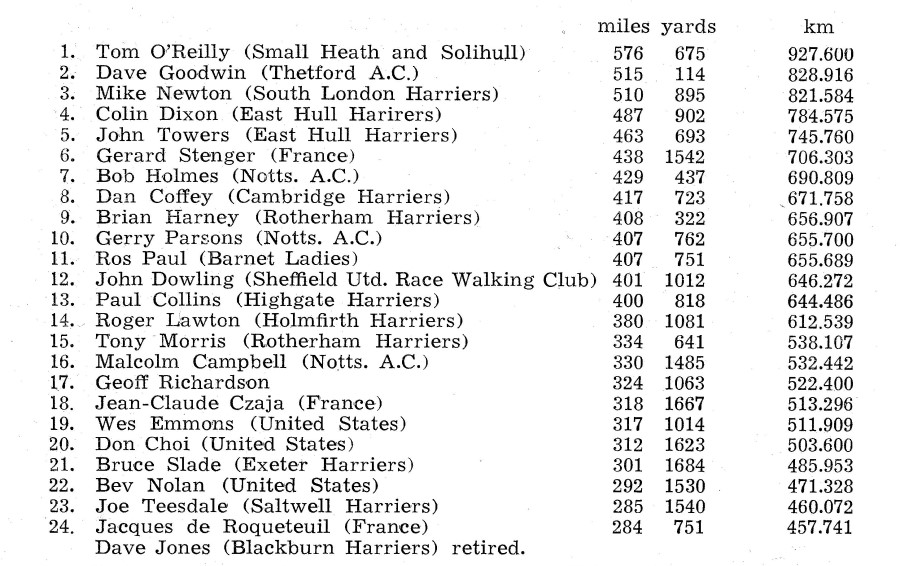
Race results from the Road Runners Club newsletter, January 1983.
Tom O’Reilly set a new men’s “modern era” six day world record, improving it by over 75 miles7. Dave Goodwin and Mike Newton were also over the previous record set by Newton at the same race the previous year.
Ros Paul ultrarunner
Ros Paul’s ultrarunning career is split into two phases. At first, I found this entry on the Deutsche Ultramarathon Vereinigung (DUV) website. It only lists four races. They were in the space of 12 months from September 1981 to August 1982.
- September 1981 – Paul finished second behind Lynn Fitzgerald in the 53-mile London to Brighton race with a time just under 8 hours.
- May 1982 – Paul finished second in the Gloucester 24 Hour Track Race, with Lynn Fitzgerald first again8. Fitzgerald was 5th overall and Paul was 7th overall, the only women in a field of 20.
- June 1982 -Paul finished first in the R.M. Wright 100km Race, a road race in Grantham.
- August 1982 – the Charles Rowell Six Day Race
Ros Paul married Jonathan Cox in January 1983 in St Albans. A race report in the Road Runners Club newsletter in August 1984, mentioned that she had had a baby. It said that she hoped to return to ultrarunning.
I have updated this post after finding a picture showing “Roz Cox” competing with her father, Norman Paul, in the South London Harriers 30 (miles) race in 1986. This led me to a second DUV entry – Rosalind Cox – which lists another four races:
- September 1986 – South London Harriers 30 where Cox finished second behind Hilary Walker
- October 1986 – she finished second behind Eleanor Adams in the London to Brighton race in under 7 hours 40 minutes
- February 1987 – she finished fourth in the Milton Keynes Indoor 24 Hour Ultra behind Adams, Walker and Arlette Touchard of France
- May 1989 – Cox finished third in the Nottingham 100km behind Walker and Sylvia Watson
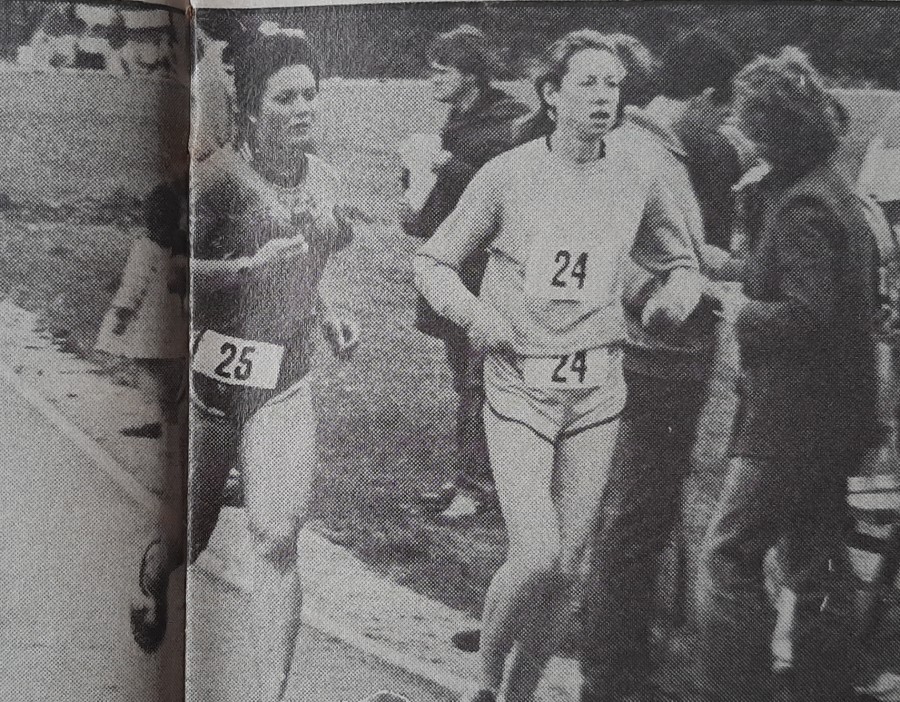
Ros Paul and Lynn Fitzgerald competing in the Gloucester 24 Hour Track Race, May 1982, photograph by Richard Thomas, Marathon and Distance Runner September/October 1982
In conclusion
Andy Milroy and Maurice Dillon highlighted the significance of Ros Paul’s performances. Dillon even commented in his report on the Gloucester 24 Hour Track Race that some women might be better suited to endurance events than to the shorter distances they had been limited to in the past.
“The individual performances of Lynn Fitzgerald and Roz Paul are beyond praise and to see both ladies finish this most testing of races in such good physical shape speaks volumes for their will power. The ladies stole the show.
….
“It is interesting to speculate that girls with an abundance of stamina, who are always being beaten for speed over the country or road could realise their full potential in future long distance race events.”
Women’s distance running was a growing sport in the early 1980s. But in 1982, it was still only seven years since the rules limiting women in the UK to short races had been changed. Until April 1975, women in the UK could not race over distances in excess of 6000m. Most road races were organised by men and not all organisers were keen to admit women to their races. This makes women like Ros Paul and Lynn Fitzgerald particularly remarkable. They were part of a small handful of women who were staking their claim as ultrarunners at a time when some British road races were still excluding women. A report on the Gloucester 24 Hour Track Race demonstrates that women were not always welcomed at ultramarathons. Referring to Lynn Fitzgerald and Ros Paul it says: “women running long distance was still not accepted by many and indeed they were laughed at by some of the men as they lined up at the start; but they were soon to be laughing out of the other side of their faces!“8
Nottingham was to remain the world-leading women’s six day race for another year. In 1983, Ros Paul’s record was broken at the third Charles Rowell Six Day Race by the woman who would prove to be the preeminent six day ultrarunner, Eleanor Adams.
Notes
Summary of the world record progression
1. During the Victorian pedestrian era there was a craze for six day races in 1870s and 1880s. In 1879, Amy Howard set a women’s record of 393 miles at a race in New York. This post on Davy Crockett’s Ultrarunning History website has a list of the principal women’s six day races in the 1870s.
2. Notably, in 1880, Charles Rowell covered over 566 miles in a six day race at the Agricultural Hall in Islington, London. This was a new world record.
3. Road Runners Club newsletter, January 1983
4. The athletics track is still in use and is the home of Notts AC but the cycle track fell out of use. The Notts 10, Nottinghamshire’s oldest road race, originally started and ended on the track.
5. “The complex problems of the 48 hour track race”, Maurice Dillon, Marathon and Distance Runner, July/August 1982
6. With thanks to the Road Runners Club for permission to reproduce this content.
7. A British runner, George Littlewood, set the Victorian era record in New York in 1888: 623.75 miles/1003km. Source: “The History of the 6 Day Race” by Andy Milroy, 2008.
8. Lynn Fitzgerald set women’s world bests at 24 hours, 50 miles, 100km, 150km and 200km at the Gloucester 24 Hour Track Race in May 1982.
9. “The Gloucester 24 Hour Track Race 2014 – a tribute to remember!” by Philip Howells, July 2014, Gloucester AC website
Photos
Banner photograph: Harvey Hadden Stadium in 1983 by Edgar Lloyd, purchased from Picture Nottingham
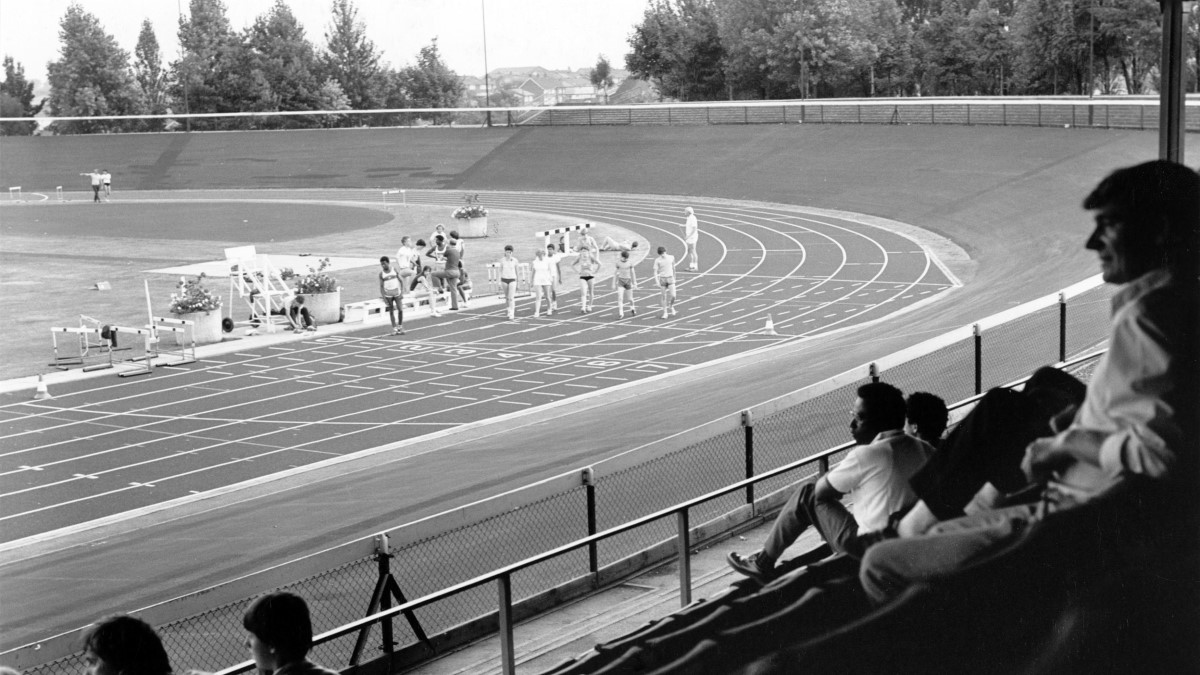

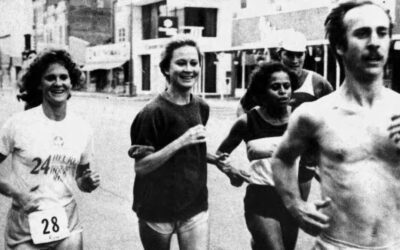
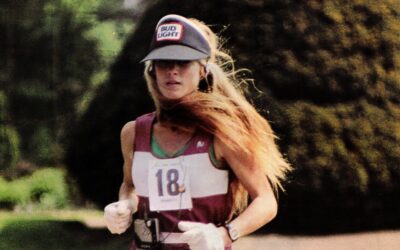
Thank you for this article! I’d not seen any of this before. The detail of the arduous 6 day race, and how Ros (mum) smashed though the records is inspiring. She went on to have 6 children and is still running
Hello Sandy, thank you for commenting. I am pleased you enjoyed the article. Your mum had quite an impact of ultra running at a young age. It’s good to hear that she is still running. Katie